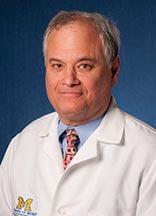Administrative Contact
Arris Todd: 734-615-2479
Biography
Dr. Terry J. Smith, the Frederick G.L. Huetwell Professor Emeritus in Ophthalmology and Visual Sciences at the University of Michigan, is an internationally-known endocrinologist who has studied Graves’ disease, its eye manifestations, and related autoimmune disease for over 20 years. Dr. Smith’s laboratory was first to describe the unique molecular attributes of tissue surrounding the eye that make it susceptible to inflammation in Graves' disease. He has identified a novel autoantibody that binds to and activates a specific receptor, resulting in an exaggerated autoimmune response. His investigation of these mechanisms has yielded several potential therapeutic targets that may interrupt the disease process. These will provide the focus for future clinical trials.
Dr. Smith received his medical degree from the University of Missouri School of Medicine and completed his residency at the University of Illinois in Chicago and Sinai Hospital in Baltimore. He has completed fellowships in biophysics at the University of California School of Medicine, San Francisco, in molecular biochemistry at Columbia University in New York, and clinical endocrinology at the Pritzker School of Medicine, University of Chicago.
Dr. Smith is the author of over 275 articles and book chapters, and has been awarded five patents for his research discoveries. He has been elected to the Orbit Society, is chief scientific officer for the National Graves' Foundation, and serves as reviewer for numerous scientific journals. Dr. Smith has been funded continuously by the National Institutes of Health and the Veterans Administration since 1983.
Areas of Interest
Research Summary
Autoimmune thyroid disease, extracellular matrix, cell signaling, gene expression, ecosanoids, inflammation and cytokine action
Dr. Smith's laboratory group is interested in understanding and developing new treatments for Graves' Disease (GD) or thyroid-associated ophthalmopathy (TAO).
Graves’ Disease is an autoimmune process directed primarily at the thyroid. Many of the patients with GD also exhibit inflammation of the tissues around the eye. Orbital manifestations of GD known as TAO, involve the dramatic remodeling of connective tissues surrounding the eye. Alterations in orbital tissue architecture can adversely affect the function and health of the eye in several ways.
- They can deprive the globe of normal irrigation and eyelid coverage, leading to chronic irritation and infection.
- They can compromise the ability of the eyes to move in a coordinated fashion, restricting motility, and resulting in disconjugate gaze and diplopia.
- They can cause cosmetic changes that sometimes exert a profoundly deleterious impact on the psychological health of afflicted patients.
- They can threaten eye sight by compressing the neuro-vascular supply to the eye.
There are no specific safe and effective therapies for TAO. Our overall goal is to identify the molecular and cellular mechanisms responsible for the pathogenesis of orbital involvement in TAO. We have found that patients with TAO have dramatically increased numbers of circulating fibrocytes. These fibrocytes derive from stem cells originating in the bone marrow. They infiltrate the connective tissues of the orbit. We believe that the phenotypic attributes of orbital fibroblasts underlie the propensity of the tissues surrounding the eye to become involved in GD. As a direct consequence of identifying the peculiarities exhibited by these cells, we are now in a strong position to create strategies for interrupting the disease process at a very early stage.
Their work is focused on defining the molecular targets that will lead to effective and specific therapy design.
Clinical Interests
Graves' disease, thyroid-associated ophthalmopathy, metabolic diseases
Specialties: Endocrinology, Internal Medicine
Credentials
- Medical School - University of Missouri School of Medicine, 1975
- Residencies
- Department of Medicine, University of Illinois, Chicago, IL, 1976
- Department of Medicine, Sinai Hospital, Baltimore, MD, 1977
- Fellowships
- Biophysics, Cardiovascular Research Institute, University of California School of Medicine, San Francisco, CA, 1978
- Biochemistry, Columbia University, New York, NY, 1979
- Endocrinology, Pritzker School of Medicine, University of Chicago, Chicago, IL, 1981

